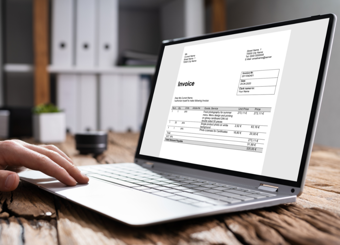The ROI of remote work
In an increasingly mobile-first world, it’s not surprising that many companies are moving toward a remote workforce. The current global COVID-19 pandemic has challenged businesses to protect their employees by putting systems and processes in place that support remote working. The advantages of modern technology can provide the same level of communication and access for remote workers as the traditional, in-office employees.
The future of working remotely from anywhere is sure to expand rapidly, as more people need or choose to work at home, and as businesses recall the scramble they faced to enable a remote working environment in the face of unexpected challenges. Consider this cost-effective strategy to employ with your accounts payable team and realize a measurable return on investment.
Why remote work appeals to employees
When things return to normal, and there isn’t any social distancing guidelines requiring remote work, there is still great appeal to having remote work as an option for employees. It’s no secret that most workers prefer the option to telecommute. It gives your staff more control over their time and the flexibility to adapt their work schedule to the demands of their day-to-day life. Seasonally, this means that summer and holidays are more easily spent with family and friends since they can travel at off-peak times and still fulfill their job duties from another location. Plus, businesses will have a remote working system in place to seamlessly handle any situation, from a pandemic to a natural disaster.
From a wellness perspective, working remotely is a more forgiving employment style for employees. They can keep up with personal medical appointments and adjust their schedule as needed. Remote employees can also care for sick children or aging parents without having to go through the time-consuming process of requesting an hour out of the office to facilitate routine business. In the face of a pandemic, employees feel less anxious because they can work remotely.
For accounts payable, the development of cloud-based automation makes telecommuting possible for the entire staff. Modern AP automation gives employees access to relevant data and systems from both desktop and mobile devices so that they can fulfill their daily tasks from anywhere in the world. Business users working remotely can easily approve invoices on their cell phones and communicate with AP staff through comment and chat functions. As for management, cloud-based technology means that all data is in real-time and up-to-date, so the reports they pull while working from home are accurate and reliable.
Benefits of remote workers for employers
The benefits of telecommuting aren’t only just for employees. Especially in today’s pandemic situation, it’s essential to have operations continue as close to business as usual as possible. Companies who enact remote work policies also reap the rewards of remote workers, whether in special circumstances or in normal situations. In reduced operations costs alone, companies can begin to see a return on investment for offering telecommuting options to employees. Think of this in the context of a company that allows employees to work from work just one day per week. Over the course of the year, that’s 52 days worth of utilities, maintenance, and real estate infrastructure that the company can save. Now consider that on the scale of a full-time remote employee, and you can imagine the kind of savings possible as we consider the future of working remotely from anywhere.
Companies also benefit from the same advantages their remote workers enjoy. Employees are now free to manage their health and personal life needs, making them ultimately more productive and happier with less time away from work. In the high-pressure, fast-paced world of AP, that’s an incredibly valuable and attractive benefit for both employee and employer. There’s a bonus of environmental benefits and a carbon footprint reduction from fewer cars on the roads due to commuting to and from the office. Working remotely makes a company far more green in the eyes of the general public. With the world facing a pandemic, the public also recognizes companies that can quickly keep operations moving forward remotely.
As more and more companies adopt AI and automation solutions for their accounts payable process, the future of a remote workforce becomes increasingly unavoidable. Companies will fare better by implementing these digital transformation technologies now and benefit from years of savings as the workforce shifts to a telecommute structure. With automation in place, the AP staff can confidently perform their daily tasks from anywhere, knowing that they have access to relevant AP data and systems in real-time. A user-friendly automation system also means a high adoption rate from your remote staff, which lends itself to readily updated and accurate information.
The benefits generally outweigh the risks of moving toward a remote AP staff structure. The evolution of the automation technology available covers most of the risk. Digitizing invoices and their data make it possible for employees to locate the key data on an invoice quickly and reference back to corresponding data points on the digital purchase orders and/or goods receipt. By eliminating paper copies, the AP staff can maintain an up-to-date digital repository for all crucial finance documents. And by integrating all of their systems into a connected cloud-based ecosystem, they reduce the risk of duplication.
Attracts unique talent to your AP department
With the increasing competition for new talent in accounts payable and finance, offering flexible remote work policies for new hires could be an effective strategy to stand out among other companies hiring. Working from home is also far more appealing to today’s college graduates, and younger employees who have been exposed to, and are more familiarized with, the concept of learning through and participating in online group settings.
It’s not just the youth that would benefit from telecommuting. Parents, especially women, are less likely to leave their positions if they can balance work and family life by working remotely for a share of the time. Accommodating women is particularly important in the finance industry’s attempt to balance out a male-dominated workforce and undergo changes to make the job more friendly to working women.
As the current workforce ages, remote work will likely become the most attractive option for retaining senior level employees aged 64 or older. A 2008 study by AARP found that 74% of respondents wanted a flexible work schedule, and 34% explicitly stated wanting to work from home. Whether full or part-time, the option to telecommute will mutually benefit the employee and employer. Employees can shift the cost of commuting and continue to earn wages from their home, and employers can keep their most experienced staff on the team for more extended periods of time to train new accounts payable employees and keep existing systems running smoothly.
Measuring the ROI for your AP department
Much like AP automation, the future of working remotely from anywhere is bright. The two can be a perfect complement to each other, improving productivity and lowering total costs for the organization. In 2016, 43% of US workers telecommuted, and you should anticipate that number to rise sharply in the coming years as remote work becomes the new norm. Also, the top talent you hope to attract and retain for your AP department will have this option available, particularly millennials who are accustomed to working and accessing info online.
The top 100 companies with remote jobs in 2018 cite numerous benefits of hiring telecommuters, including improved customer satisfaction (which leads to a boost in revenue), more diverse talent pools, and more loyal and engaged workforce. They also refer to the geographic benefits of being able to hire employees anywhere in the world. These companies have the opportunity to draw from a larger applicant base for the specific skill set they seek, as well as access to key geographic targets that otherwise would be harder to penetrate with an office-based workforce.
Harness the power of technology to overcome complications
With all of these benefits in mind, how can you prepare your organization to take advantage of the future of remote work? There are several steps now to ensure a successful path to a remote workforce down the road. First, implement robust solutions for finance and accounts payable that will equip your staff with the tools they need to do their job from anywhere. If your staff remains tied to antiquated systems and processes only accessible from a physical office location, there’s no way you can successfully allow staff to telecommute.
Take advantage of communication tools to ease the process of connecting with other staff members around the world. Skype and other video conferencing tools are advanced enough at present to contribute to socialization that rivals being in an office location and avoids the isolation associated with remote work.
Finally, devise internal metrics to gauge remote work return on investment. Keep track of employee retention rates, overall job satisfaction, and productivity scores to make sure that your remote workforce is set up for success. Don’t forget the hard savings, too. Measure just how much your workforce is saving the company in terms of operational costs not incurred, flexible salary ranges, and decreased attrition budgets, among other metrics.
Understandably, enabling remote work is of significant importance to most businesses facing the challenges of the COVID-19 pandemic. No matter where you are in the process of adapting to the increasingly accessible world of remote work, there’s one undeniable fact that organizations need to accept about the future of working remotely from anywhere: AP automation solutions and enabling remote workers will keep companies ahead of the curve to realize impressive ROI in the next few years, and help them weather the inevitable storms.






